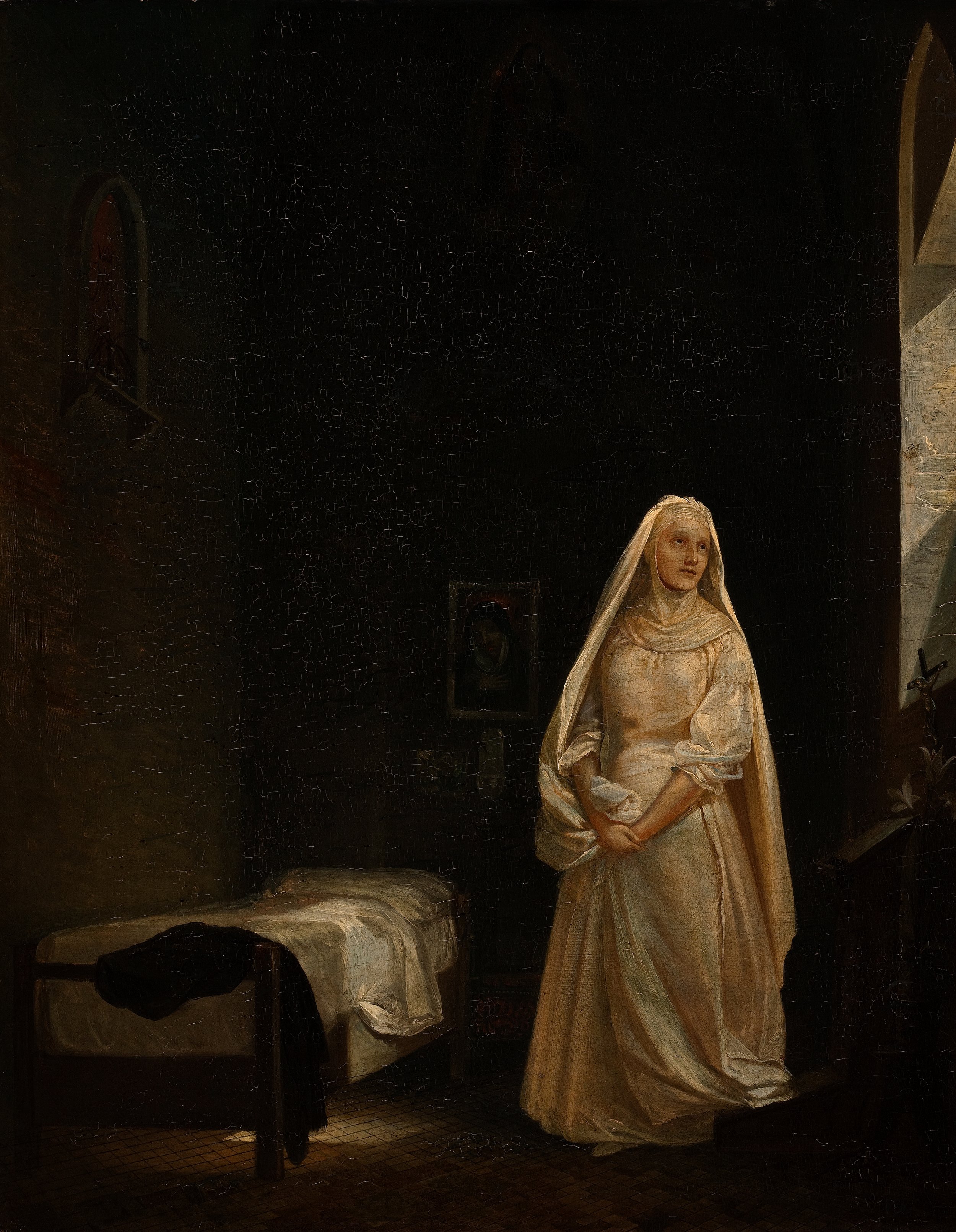Praying in Greek Tragedy

Praying in Greek Tragedy
Carolyn Etzel Branch
On the Allure & Art of Mysticism
My sister says her favorite weather is the moment just before a storm where the earth rolls and yawns with thunder. When she was little, she would ride her bike in looping circles in front of the house while the air crackled and the green trees shook silver, ignoring calls to come inside before the sky purged itself of electricity. She revels in that moment of cosmic surrender, where it all finally comes crashing down.
That affection for the full-bodied chaos of cleansing is a little sliver of mysticism in my sister. The natural world, her imagination, and the joy of the presence of God all met in each arc of her bicycle. I’d venture we can all picture some version of this, the wild innocence of mysticism caught in real life. Mysticism is a siren’s call to the modern Christian contemplative and I am not immune to its allure. It’s fashionably, tastefully eerie. In a world allergic to uncertainty, mysticism extends an invitation to come and sit awhile with what we do not understand, to peer into luminous darkness and encounter a God who is bigger than not only our answers, but our very questions. Mysticism calls forward with a crooked finger from the shadows of Medieval monasticism and affirms our wonder, our doubt, and our imagination. But mysticism is not all wisps of incense and a poetic sense of agnosticism. To dabble in mysticism is to dabble in suffering.
Medieval mystics pursued a method of contemplation often categorized as the “Mystic Path,” a three-step process of purgation, illumination, and union. Practicing ascetics would strip themselves of all detritus preventing their understanding of and intimacy with God. God would respond by illuminating their minds and souls with the presence of Christ, leading them to a final, loving union with the anguished Lord. The imagination is mysticism’s weapon of choice for cutting down the divide between the material and the divine, but that imagination finds purchase in the body, both ours and Christ’s. The imagination becomes sacramental in the mystical life.
*
Julian of Norwich depicts her mystical experience of Christ’s pain and subsequent reflection in her Revelations of Divine Love. Julian appeals to God for three requests: to suffer, to understand the suffering of Christ, and to physically receive his wounds. Her passionate love for Christ moves her to request physical suffering as a means of intimacy with Christ. Julian’s prayers for agony are answered in a debilitating illness which leaves her desperately gazing at a crucifix while the room darkens around her, stripped of any thoughts but those of the man on the cross. She describes an illumination of her mind as Christ imparts his “familiar love” to her, giving her deeper understanding of this love and his nature. The body of Christ is both the means to and the end of her communion.
Given the affective nature of mystical theology, it is unsurprising that the process of sanctification would be experiential more than cognitive. However, it is important to recognize that Medieval mystics viewed suffering as consequential to a desire for Christ more than a motivation in and of itself. Furthermore, they emphasized the loving suffering of Christ over their own pain. Contemporary scholars theorize that the mystic propensity for suffering was a response to a Medieval world where mortality haunted ordinary life; that a culture riddled with pain, sickness, and hard work resulted in theologies to make sense of them.
We have not erased suffering from modernity, but we inoculate ourselves from it by sensationalizing it in media and romanticizing it in history. We are inundated with casual grief and yet woefully unprepared to weather or articulate it. Even suffering that finds its method and measure in the body of Christ is a daunting and perilous endeavor. But that craving for that gasping moment of cleansing, the first cacophony of downpouring rain, runs back deep into the world’s story, into the very marrow of what it means to be human. In small ways, we revel in the notions of spring cleaning, grueling endurance runs, a good cry, and drastic haircuts. The purgation plays a counterpoint melody to the shimmering charm of materialism, chanting, “if you just get rid of this, everything will be fixed.”
Mystic purification looks different. It is a subtraction by addition. In order to cleanse ourselves, we take on the suffering of Christ. As simple as those words are, that much harder is the task. So how do we do mysticism now? In embracing the benefits of mysticism, how do we safely chart a course through this element of Christ’s suffering in our bodies and imaginations?
For inspiration, I turn to the other place where we discover Christ in our bodies and imaginations: the arts. Art has midwifed human suffering for millenia, but what would it look like for art to escort us through suffering as a means of grace? The arts lend methodology to imagination, giving us audio-visual language for the transcendent. From my first middle school role as a scruffy orphan, theatre has been the art that shepherds my spirituality. The word becomes flesh first onstage and is enacted in my body, as it does in its fullness when I cup the Eucharist in my hands on Sunday. My theological questions have always met a kind of resolution when I step into a dusty, paint-scented theatre, begin stretching, and let my thoughts escape through my limbs. So as I mused over mystic suffering one autumn afternoon, among a smattering of page numbers and browser tabs, I eventually asked the stage.
Aristotle describes proper tragic theatre as creating a release of spiritual and emotional toxicity called katharsis, which translated means purgation. He says, “Tragedy, then, is an imitation of an action that is serious, complete, and of a certain magnitude... effecting through pity and fear the proper purgation of these emotions.” Ancient theatre arose from a mimetic instinct to re-enact cosmogonic myths and embody ritual, but the specific structure of Greek tragedy was designed to communally release grief and evil more than simply entertain. Like the Mystic Path, the plays elicited emotions in their audience which prompted physical responses, and through this process, the griefs and impurities–called miasma–were cleansed for the community.
In addition to this, Aristotle requires tragedians to include what he calls a “Scene of Suffering” in their dramas, which he defines as “a destructive or painful action, such as death on the stage, bodily agony, wounds and the like.” Witnessing and communally experiencing suffering through the imagination offered Greek populations a healing method of emotional purgation. The involvement of the audience exceeded mere viewing, incorporating their reactions and responses into the performance the same way liturgical church services involve the congregation.
*
You may be piecing together the realization that had me gasping in the silent library that October afternoon as I pored over Julian’s story: The Passion of Christ fulfills the requirements for an Aristotelian tragedy. Tragedy hinged on a scaffolding of rules, one of them being the three unities: time, place, and action. Our tragic hero Christ faces a reversal of fortune from the Last Supper to the cross which spans twenty-four hours within the city of Jerusalem, meeting these requirements and leading us to the Scene of Suffering which the actor and spectators share like Eucharistic bread and wine. Aristotle fittingly writes that a tragedy will “thus resemble a living organism in all its unity.” So does our salvific tragedy gasp for breath on the cross.
“For the Passion was a noble, glorious deed performed at one particular time through the action of love,” writes Julian, offering further evidence that understanding the Passion as a healing theatre accurately communicates the mystic experience of transformation. Mystics beginning their path turned to the suffering body of Christ to purge themselves of unrighteousness; actors and spectators entered the theatre laden with fear and anger they wished to expunge through the performance. As the mystics ascended the stair steps of the crucified Christ, they were simultaneously stripped of their sin and given love of God, which led to suffering of their own. The audiences of Greek tragedies were encouraged to weep and mourn from their seats in the amphitheater, to enter into the suffering onstage. Thus cleansed, the mystics savored a painfully glorious intimacy with God. The Greeks exited the theater, healed of their miasma and unified as a community–a further connection with the mystics, who were also moved to love for their neighbors as a consequence of divine intimacy.
There is something transformational, healing, and unifying about experiencing pain through performance. Performance creates a sacred space that simultaneously provides intimacy and detachment, through which the suffering of salvation can be endured and explored in such a way that the spectating mystics leave the process healed, beautified, and brought near to the feet of Jesus. Aristotelian performance theory offers suffering a skeleton, a liturgy for us to journey through as we taste mysticism in modern life. When mysticism asks us to enter into Christ through our imaginations, and we feel unmoored in the painful darkness, theatre teaches us how to make sense of the mystery without demythologizing it. We learn to pray in Greek tragedy.
Christian theology is often a study in reversals, where the last are first and suffering somehow leads to restoration. The Mystic Path invites us to the theatre of God, where tragedy heals and darkness becomes light. Julian’s words echo the declarations of Isaiah 53, where the prophet cries, “With his wounds we are healed.” Entering into the death of Christ baptizes us in a suffering that affirms the truth of our cleansing through his demise. Together we descend the steps of an amphitheater, laden with aching evil, and sit while we watch that ache enacted for us on the body of our Tragedian, somehow making us well.
Carolyn Etzel Branch
Writer & Student
Carolyn is a current graduate student at Duke Divinity School, pursuing a Master of Divinity with certificates in Theology & the Arts and Anglican Studies.
Photography by Kevin Dorg




